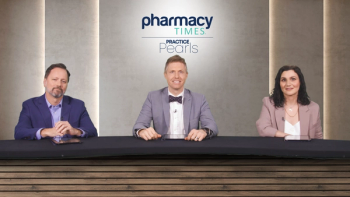
Optimal Position of CDK4/6 Inhibitors: The SONIA Trial
A description of the SONIA study is provided by Heather Moore, CPP, PharmD.
Heather Moore, CPP, PharmD: The purpose of the [phase 3] SONIA study [NCT03425838] was to look at the efficacy, safety as well as cost-effectiveness of CDK4/6 inhibitors when added to either first- or second-line endocrine therapy for patients who had hormone receptor-positive, HER2-negative (HR+/HER2-) metastatic breast cancer who had not previously received therapy in a metastatic setting.
Within the SONIA study they included patients who were both pre- and postmenopausal who had not previously received therapy for advanced or metastatic breast cancer. I do want to mention that roughly 90% of them were postmenopausal within this study, and it was a Dutch study, so it was looking at patients within 74 Dutch hospitals. Patients were allowed to have prior chemotherapy if it were in the neoadjuvant or adjuvant setting, or they needed to have at least a 12-month disease-free interval after their [aromatase inhibitor] therapy. Patients were randomized 1:1, and there were 2 different arms. They categorized arm A, which was an aromatase inhibitor in combination with CDK4/6 inhibitor, and that was physician’s choice. That could have been abemaciclib, palbociclib, ribociclib. Upon progression, patients would then receive fulvestrant. Now, in arm B, those patients started out first line with endocrine therapy with an aromatase inhibitor, and upon progression, those patients would then continue with fulvestrant in combination with the CDK4/6 inhibitor.
Looking at the results of SONIA that were presented at [the American Society of Clinical Oncology meeting], the patient population was fairly large. It included over 1000 patients within the study, and the primary end point was looking at the second objective disease progression. For the primary end point, what we saw median follow-up was 37.7 months. With strategy A, there were 31 months of progression-free survival. With strategy B, there were 27.8 months [of progression-free survival]. When looking at the median time that patients were on CDK inhibitors, strategy A—and again, that was using CDK in the first line—was 24.7 months compared [with] strategy B, which was 8.3 months.
The SONIA data also looked at overall survival in both of those patient groups. What they found is that for patients who were receiving strategy A—patients receiving CDK4/6 inhibitors in the front line—their overall survival was 45.9 months. Strategy B—CDK4/6 inhibitors in the second-line setting—had an overall survival of roughly 53.7 months.
Looking at the safety profile of the SONIA study and how that differed between groups, specifically focusing on grade 3 adverse effects, what we saw within strategy A—upfront CDK4/6 inhibitor]—was significantly higher with 2778 events compared to strategy B [CDK4/6 inhibitor in second-line] at 1620 events. What we also saw is that there were 42% more grade 3 events when CDK4/6 inhibitors were used in the first line, which can impact quality of life. They did look at quality of life, specifically looking at what they use was a FACT-B [Functional Assessment of Cancer Therapy – Breast] total score and saw that there really was no difference between arms.
When they’re comparing the cost-effectiveness with group A vs group B for patients who received CDK4/6 inhibitor in the first line—strategy A—that increased the drug expenditure by roughly $200,000 per patient vs when patients started with endocrine therapy in the first line.
The study conclusion of SONIA was one that is really important, and that they showed that first-line CDK4/6 inhibitor in combination with endocrine therapy did not provide a statistically significant or clinically meaningful progression-free survival when compared [with] just second-line use. What they showed, and I want to differentiate their results vs my takeaways, but it prolonged the time of having to use a CDK4/6 inhibitor by roughly 16.4 months. However, it also led to increased toxicity and cost, meaning that second-line CDK4/6 inhibitor can be preferred. Endocrine therapy as a monotherapy still remains an excellent option in the first line. The SONIA study helps to confirm that we can consider endocrine therapy monotherapy first line for some patients.A of the limitation of the study is that when you think about the second-line strategy that they used for strategy B is that for patients who had progressed on CDK4/6 inhibitors in combination with endocrine therapy, they transitioned them to fulvestrant monotherapy. We know from thinking about the [phase 2] VERONICA [trial] [NCT03584009] data as well as the [phase 2] MAINTAIN [trial] [NCT02632045] data that fulvestrant monotherapy is probably a subpar therapy and, what would have been probably a better next line of treatment would have been physician’s choice. Some of that could have been targeted or tailored based off of next-generation sequencing. For instance, if a patient would have had PIK3CA mutation and using alpelisib, or if patients would have had an ESR1 mutation and being transitioned to elacestrant. The second line was not a fair next line of therapy and thus may have biased or modified their results a little bit.
Because of this, this limits the extrapolation to a real-world setting what we would otherwise do in clinic. SONIA does support and validate the decision for monotherapy endocrine therapy for patients who otherwise may not be able to tolerate or may not be eligible for a CDK4/6 inhibitor. It does help to validate some of that decision-making. I wouldn’t implement this as the standard of care, though, based off of those limitations. I do still think, based off of the data that we have with our MONARCH studies [NCT02107703 and NCT02246621], PALOMA [NCT01740427], and MONALEESA [NCT01958021] that our gold standard should still very much be CDK4/6 inhibitor in combination with endocrine therapy.
There are a lot of challenges that can be considered when implementing CDK4/6 inhibitors in advanced breast cancer. One is the selection. We have to take into account not only the efficacy but also the toxicity profiles of CDK4/6 inhibitors. Taking into the overall survival data from MONARCH as well as the MONALEESA studies, there are times when we may think that ribociclib and abemaciclib are preferred, but I also think we have to think about the toxicity profiles as well as the patient characteristics when we’re making that decision as well as some of the monitoring. When making that decision and from an adverse-effect profile, we need to be mindful of the QTc prolongation that we may see with ribociclib or monitoring and managing diarrhea with abemaciclib, as well as the overall mild suppression that we can see with all of these agents. We also have to be mindful from a procurement standpoint that these drugs are all very expensive, so sometimes we may have to get patient assistance involved or [make] sure that we can procure therapy for patients, especially in patients who are on Medicare or older patients, just because their co-pays otherwise are several thousands of dollars. That’s per month, so sometimes that can be difficult for patients to continue. From a procurement standpoint, it’s really important that we do have patient assistance involved. Overall, it’s being mindful of the toxicity profile that’s associated with these drugs, but also the financial toxicity.
Transcript is AI-generated and edited for clarity and readability.
Newsletter
Stay informed on drug updates, treatment guidelines, and pharmacy practice trends—subscribe to Pharmacy Times for weekly clinical insights.


